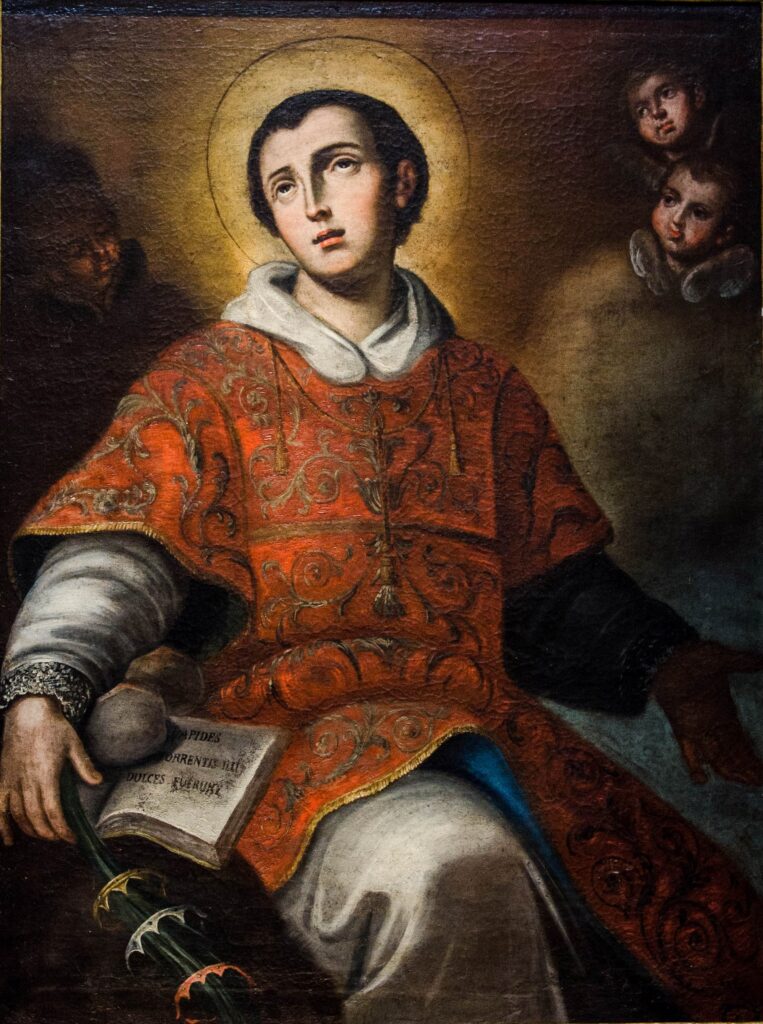The unknown painter has a precious description of details: the applications to embroidery with phyto-forms, the tassels hanging on the chest, the gilded trimming. A nineteenth-century liturgical vestment of the Cathedral of Milazzo, in red silk and gold embroidery, with the coat of arms of the Proto family, presents the same decorations as the dalmatic of the holy portrait. In the absence of any archival documentation, it is possible to trace back only to a hypothesis of the work’s dating, which can be assigned chronologically between the 18th and 19th centuries. The painting is stylistically attributable to the hand of the painter Giuseppe Russo, active between the eighteenth and nineteenth century in Milazzo and the Tyrrhenian area of Messina. The face of the saint can be compared with some of his stereotypes, typical of his works of sacred subject, usually populated by several characters. In addition, the same descriptive forecast of the sacred vestments of some of his paintings is visible in San Lorenzo (Frazzanò, church of S. Lorenzo) and in the Mass of San Gregorio (S. Marco d’Alunzio, church of S. Nicolò). It can be assumed that the artist was inspired by the statue of Santo Stefano Protomartire, which was commissioned for the Cathedral, along with the coffin of the saint, to the sculptor Filippo Quattrocchi, documented in 1786 in Milazzo.
Saint Stephen Protomartyr

Author: Giuseppe Gesualdo Russo (Barcelona Pozzo di Gotto (?), documented between 1770 and 1805) attr.
Dating: End of the XVIII sec. – beginning of the XIX sec. sec
Material: Oil on canvas
Dimensions: cm 105×75
Location: Milazzo, cathedral of Santo Stefano Protomartire
The work is placed in the sacristy of the cathedral of S. Stefano di Milazzo, perhaps coming from the Duomo Vecchio. The young saint with halo is represented in an ecstatic attitude with his gaze turned to the sky, and holds with his right hand his iconographic attributes presented in the foreground: the stones, the allusive book of the diaconate, the palm within three crowns. The inscription on the book, “LAPIDES TURRENTIS ILLI DULCES FUERUNT”, referring to the martyrdom by stoning. He wears liturgical vestments, typical of the time, described with detail: the white robe enriched by embroidery on the wrists; the dalmatic red carmine falling over the leg of the saint, which lets see the blue lining.
The statue made in 1784, from Palermo reaches Milazzo in 1786, with great jubilation of the population. The work of Russo is to be noted for his contribution on painting the territory of Milazzo di Biliardo, with a brief reference to several works attributable to the painter. For a deeper insight into his production, I refer to my recent article (Bottari, 2013, pp. 549-562), in which the considerable contribution of the artist, now considered a “minor”, within that circle oflocal painters, who have not yet been the subject of an adequate study: they are families of artists such as Viscosi, Bonsignore, or painters who worked individually, like Antonio Buongiorno. The painter already lived in Milazzo in 1785. His paintings can be found at the cathedral of S. Stefano, the church of S. Giacomo, the church of the Rosary. The most important commitment was the complex of the furnishings for the church of the Carmine, chronologically assigned to the end of the eighteenth century, including four altarpieces and probably six of the eight ovals embedded in the side walls, in which the collaboration of Viscosis painters, or Vescosi, culturally close to him is confirmed: Antonio, Filippo and Vito Viscosi, painters from Pozzo di Gotto and documented in Castroreale. According to his few certain works, a considerable number of devotional altarpieces can be attributed to the Russo, which probably had a certain importance in the past, given their preminent placement within ecclesiastical buildings.